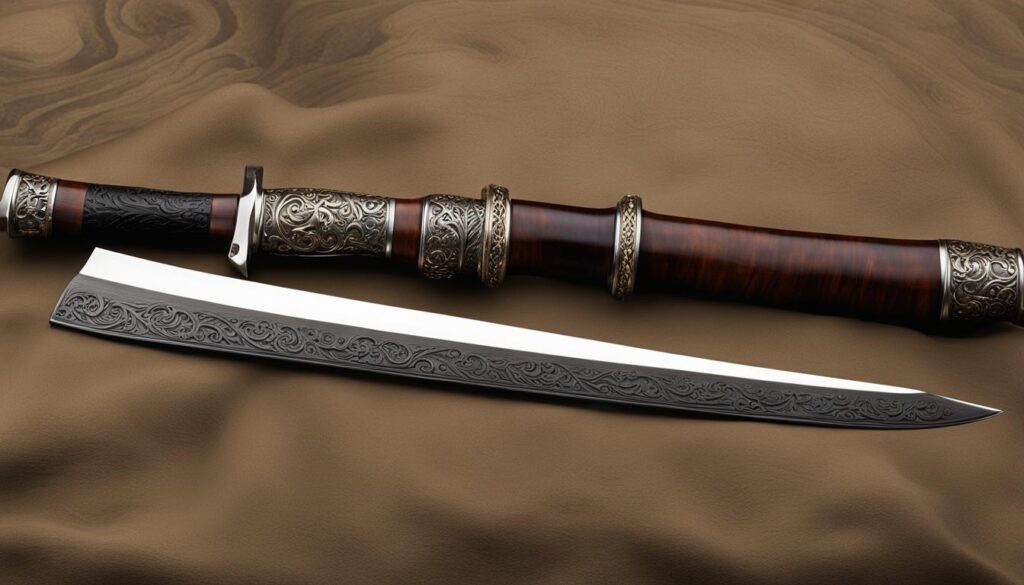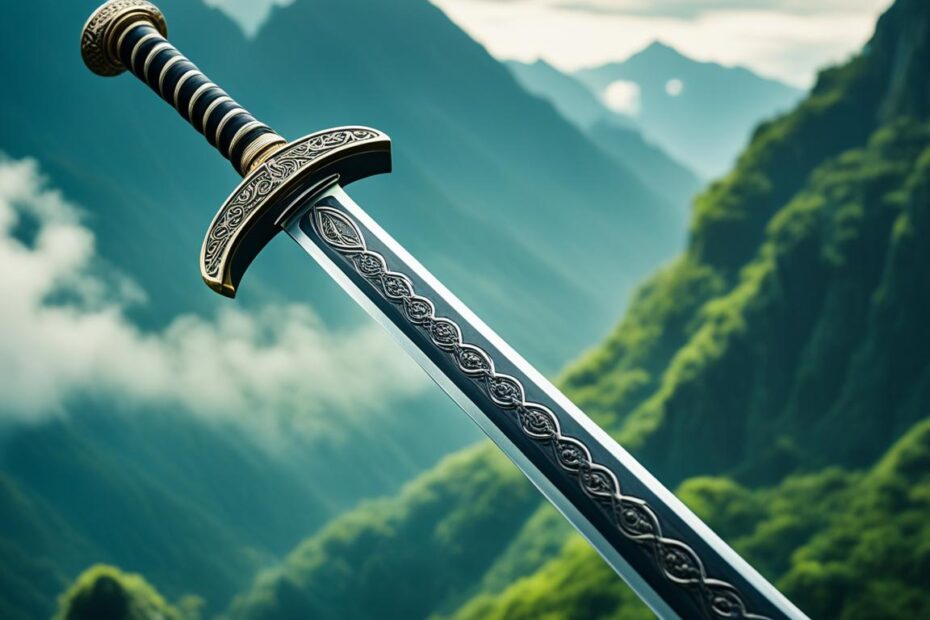Welcome to our exploration of the Sword Straight Gunong – a remarkable traditional blade with a rich history. This Filipino weapon embodies elegance and showcases exquisite craftsmanship, making it a true treasure for enthusiasts and collectors alike.
Throughout the ages, the Sword Straight Gunong has played a significant role in Filipino culture. Its origins can be traced back centuries, and it holds a special place in the hearts of martial arts practitioners and history enthusiasts. With its unique design and historical significance, the Sword Straight Gunong continues to captivate and inspire.
In the upcoming sections, we will delve into the fascinating history, detailed craftsmanship, and cultural importance of the Sword Straight Gunong. Join us on this journey of discovery as we unravel the secrets behind this extraordinary weapon.
Stay tuned for the next section where we will uncover the historical origins and significance of the Sword Straight Gunong in Filipino culture.
History of the Sword Straight Gunong
The Sword Straight Gunong holds a captivating history that spans centuries, making it a significant part of traditional Filipino weapons. This awe-inspiring blade has deep historical significance and carries with it tales of valor, culture, and martial arts.
The origins of the Sword Straight Gunong can be traced back to the rich heritage of the Philippines. It emerged as a vital weapon for Filipinos in their struggle for independence and self-defense.
Over time, the Sword Straight Gunong evolved, not only as a tool for combat but also as a symbol of Filipino martial arts. Its distinctive design and remarkable craftsmanship became a representation of Filipino culture.
“The Sword Straight Gunong is more than just a weapon; it embodies the spirit and traditions of the Filipino people.” – Master Armando Rivas, Filipino Martial Arts Expert.
Throughout history, the Sword Straight Gunong has played a significant role in various aspects of Filipino culture. From tribal conflicts to colonial resistance, this traditional blade has been a testament to the determination and resilience of the Filipino people.
Fascinating Tales of the Sword Straight Gunong
One such tale revolves around Lapu-Lapu, a legendary Filipino hero who utilized the Sword Straight Gunong in the Battle of Mactan against the Spanish colonizers. His courage and mastery of the weapon symbolize the resistance against foreign forces.
Another iconic figure associated with the Sword Straight Gunong is Bagani, the warrior class of ancient Filipino societies. These skilled fighters wielded the blade with precision, defending their communities from external threats.
The historical significance of the Sword Straight Gunong cannot be overstated. It represents the struggles, triumphs, and heritage of the Filipino people, acting as a tangible link to their ancestors and the evolution of Filipino martial arts.
Historical Significance
The Sword Straight Gunong’s historical significance lies in its role as a cultural artifact and martial tool. It has been an integral part of Filipino identity, reflecting their warrior heritage and determination to preserve their traditions.
The use of the Sword Straight Gunong extends beyond its historical context. Filipino martial arts practitioners continue to train with this weapon, incorporating it into their fighting techniques as a way to honor their ancestors and pass on their cultural legacy.
With its deep-rooted historical significance and cultural relevance, the Sword Straight Gunong stands as a testament to the resilience and ingenuity of the Filipino people. It remains an enduring symbol of their unwavering spirit and commitment to preserving their traditions.
Craftsmanship and Design of the Sword Straight Gunong
The Sword Straight Gunong is renowned for its exquisite craftsmanship and unique design, making it a treasured piece of Filipino heritage. Skilled Filipino craftsmen have dedicated their expertise to meticulously constructing these blades, resulting in a weapon of unparalleled beauty and functionality.
The construction of the Sword Straight Gunong involves intricate techniques and the use of high-quality materials. The blade is meticulously handcrafted, with attention to every detail, ensuring precision and durability. The hilt is carefully sculpted to fit perfectly in hand, providing a comfortable grip and enhancing control during combat.
One of the distinguishing features of the Sword Straight Gunong is its elegantly curved pommel, which adds to its visual appeal. This unique design element sets it apart from other traditional Filipino weapons, making it instantly recognizable. The craftsmanship and design of the Sword Straight Gunong exemplify the rich artistic traditions of the Filipino culture.

Each Sword Straight Gunong is a testament to the mastery and skill of Filipino artisans who have honed their craft over generations. Their dedication and attention to detail are evident in the flawless execution of every component of the weapon.
“The craftsmanship of the Sword Straight Gunong truly captures the essence of Filipino artistry. The attention to detail and the skill required to create such a remarkable weapon is unparalleled. It is a testament to the rich cultural heritage of the Philippines.” – Antonio Gomez, Filipino Martial Arts Historian
Intricate Construction Process
The construction process of the Sword Straight Gunong involves a series of meticulous steps that require expert knowledge and precision. Skilled craftsmen employ traditional methods passed down through generations to create these exceptional weapons.
| Construction Step | Description |
|---|---|
| Blade Forging | The blade is meticulously forged using high-quality steel, heated, and hammered into shape. This process ensures the blade’s strength, flexibility, and sharpness. |
| Hilt Carving | The hilt is carefully carved from sustainable hardwood, such as Kamagong or Molave. The craftsmen painstakingly sculpt the intricate designs and shapes, ensuring an ergonomic grip. |
| Assembly | The blade and hilt are meticulously joined together using traditional adhesives and fasteners. This intricate process requires a balance of strength and flexibility to ensure the weapon’s durability. |
| Finishing Touches | Once assembled, the Sword Straight Gunong undergoes meticulous finishing, including polishing, sharpening, and engraving. These final touches enhance its visual appeal and character. |
The end result is a Sword Straight Gunong that showcases the exceptional craftsmanship and attention to detail characteristic of Filipino artistry. Its unique charm and visual appeal make it a coveted weapon for collectors, martial artists, and enthusiasts alike.
Modern Applications and Cultural Significance of the Sword Straight Gunong
The Sword Straight Gunong, a remarkable Filipino weapon with a rich heritage, continues to hold relevance in modern times. Not only does it serve as a historical artifact, but it also plays an integral role in Filipino martial arts. This iconic blade is deeply rooted in the cultural heritage of the Filipino people and stands as a symbol of their identity.
Throughout the years, the Sword Straight Gunong has showcased its versatility and effectiveness in traditional fighting techniques. Practitioners of Filipino martial arts, also known as Arnis or Kali, skillfully wield this blade, utilizing its unique design and techniques passed down through generations.
Beyond its significance as a combat weapon, the Sword Straight Gunong embodies the preservation of Filipino cultural heritage. It serves as a physical representation of the skills, artistry, and craftsmanship of Filipino blacksmiths and craftsmen. Through the continued practice of Filipino martial arts and the appreciation of this traditional blade, the cultural identity of the Filipino people is honored and upheld.
